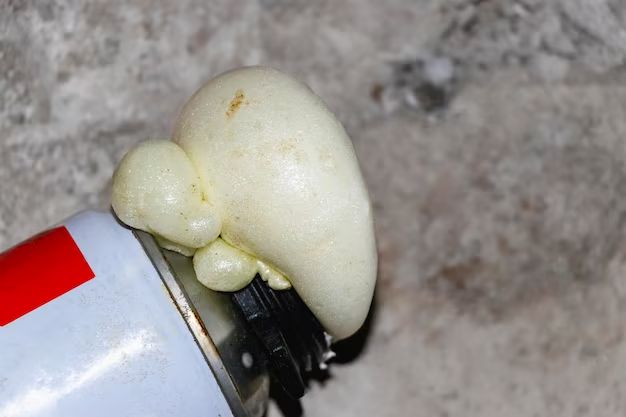Yes, it is possible to get polyurethane in a spray can. Polyurethane is a versatile material that can be formulated as a liquid and applied as a spray coating. Manufacturers make polyurethane coatings and sealants available in aerosol spray cans for small applications and touch-ups.
Page Contents
What is polyurethane?
Polyurethane is a polymer composed of organic units joined by urethane links. The urethane links are formed through a chemical reaction between an isocyanate component and a polyol component. By varying the isocyanate, the polyol, and other ingredients, polyurethanes can be tailored to produce materials with a wide range of properties and applications.
Here are some key facts about polyurethane:
- Polyurethane polymers can be thermosetting or thermoplastic.
- Polyurethanes are used in foam, coatings, adhesives, sealants, elastomers, and other materials.
- Flexible, rigid, and semi-rigid polyurethane foams are widely used in upholstered furniture, bedding, automotive seats, carpet underlay, and insulation.
- Polyurethane coatings are valued for their durability, flexibility, abrasion resistance, and gloss.
Types of polyurethane coatings
There are several different types of polyurethane coatings that may be available in spray cans:
- Oil-modified polyurethane – These coatings contain polyurethane resins dispersed and reacted in drying oils. They provide a flexible, abrasion-resistant finish.
- Moisture-cured polyurethane – These coatings cure through reaction with moisture in the air. They are ideal for wood substrates.
- Two-component polyurethane – These coatings contain separate polyol and isocyanate components that must be mixed immediately before application. They form a durable, high-gloss finish.
- Single-component polyurethane – The isocyanate and polyol react during manufacturing to produce a stable prepolymer. These coatings cure when exposed to air and provide excellent protection.
Advantages of polyurethane spray coatings
Using polyurethane in a spray can offers a number of advantages compared to applying the coating by brush or roller:
- Spray application is quick and easy for small jobs or touch-ups.
- Spraying provides a thin, even coating and reduces brush marks.
- Spray polyurethane can access hard-to-reach areas and vertical surfaces.
- Aerosol application minimizes the mess and cleanup of paint buckets and brushes.
- Spray cans allow using just the needed amount of coating without dealing with partial cans.
Where to find polyurethane spray paint
Polyurethane coatings in spray cans are sold at most hardware stores, home centers, paint stores, and art supply outlets. Here are some of the major brands to look for:
- Rust-Oleum Painter’s Touch
- Krylon Fusion
- Minwax Polycrylic
- Varathane Premium
- Zinsser Bulls Eye
These are available in different sheens ranging from flat/matte to high gloss. Some brands also offer specialty polyurethane sprays for particular uses like floors, cabinets, crafts, and metals.
How to use polyurethane spray paint
Polyurethane spray paint should be applied using similar techniques as other spray paints:
- Prepare the surface by cleaning it thoroughly and sanding to improve adhesion if needed.
- Cover any areas you do not want to spray and remove or mask hardware.
- If spraying a previous finish, test compatibility on an inconspicuous spot first.
- Shake the can vigorously for 1-2 minutes to mix the contents.
- Apply light tack coats rather than thick wet coats to avoid drips and runs.
- Allow proper drying time between coats as specified on the can.
- Apply thin, even coats in a well-ventilated area.
- Spray at a distance of 8-10 inches from the surface.
- Apply 2-3 coats for best durability, following all direction on the can.
Polyurethane spray paint projects
Polyurethane spray paint is useful for many household projects. Here are some ideas where a polyurethane spray can provide a tough, protective finish:
- Floors – Add polyurethane to wood, laminate, or concrete floors.
- Furniture – Protect tables, chairs, dressers, and more.
- Cabinets – Coat cabinet boxes and doors.
- Doors – Apply to wood, metal, and fiberglass doors.
- Trim – Use on baseboards, casings, moldings.
- Shutters – Coat exterior composite or wood shutters.
- Wicker – Spray outdoor wicker furniture and baskets.
- Crafts – Seal and protect wood crafts and furniture.
Polyurethane spray paint allows tackling smaller projects without pulling out the brushes. It can also be used for quick touch-ups and repairs to rejuvenatesurfaces between major refinishing jobs.
Safety tips for working with polyurethane spray paint
Observing basic safety measures when using polyurethane spray paint is import to avoid health hazards:
- Use in a well-ventilated outdoor area and wear an organic vapor respirator.
- Spray polyurethane only on calm, dry days to prevent overspray issues.
- Wear protective clothing to avoid getting spray on your skin and eyes.
- Follow all safety directions listed on the product can and MSDS sheet.
- Allow coated items to dry thoroughly before use as directed.
- Properly dispose of used spray cans according to local hazardous waste regulations.
Conclusion
Polyurethane coatings offer excellent durability, abrasion resistance, and protection for wood and other materials. While traditionally applied by brush, polyurethane formulated for spray application allows taking advantage of these benefits for small scale jobs. Polyurethane spray paints from leading brands provide convenience and quality results for refinishing and protecting all kinds of household items.
